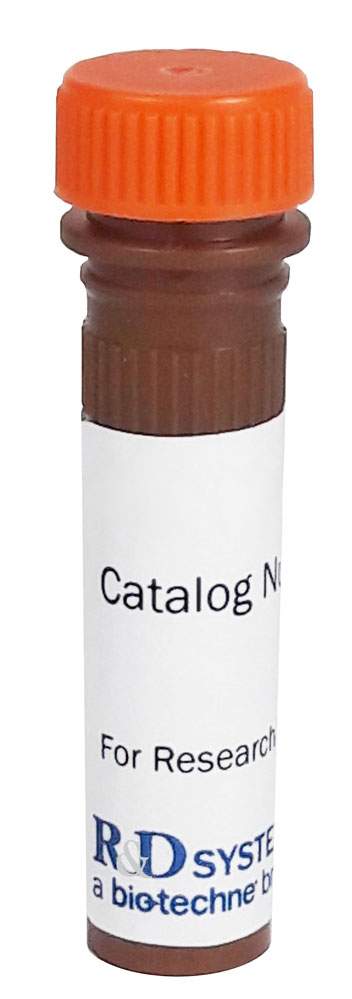Mouse MMR/CD206 Alexa Fluor® 594-conjugated Antibody Summary
Leu19-Ala1388
Accession # Q61830
Applications
Please Note: Optimal dilutions should be determined by each laboratory for each application. General Protocols are available in the Technical Information section on our website.
Reconstitution Calculator
Preparation and Storage
Background: MMR/CD206
The MMR (macrophage mannose receptor) is also called MR due to its presence on cells other than macrophages, and is designated CD206, Mrc1 (mannose receptor C type 1), or CLEC13D (C‑type lectin domain family 13, member D) (1‑4). CD206 is a 175 kDa endocytic receptor that is expressed on M2 alternatively activated tissue macrophages including tumor‑associated macrophages (TAMs), inflammatory dendritic cells in selected lymphoid organs, and liver, splenic, lymphatic, and dermal microvascular endothelial cells (1, 2, 5‑8). The 1456 amino acid (aa) mouse CD206 precursor contains a signal sequence (19 aa), an extracellular domain (ECD) containing an N‑terminal cysteine‑rich domain, a fibronectin type II repeat, eight C‑type lectin domains (CTLDs), and several N‑glycosylation sites (1369 aa), a transmembrane segment and a short (47 aa) cytoplasmic domain (2‑4). Metalloproteinases can mediate the shedding of the soluble ECD (2). The mouse CD206 ECD shares 96% aa sequence identity with rat MR, and 83‑84% with human, equine, porcine and canine CD206. The cysteine-rich domain recognizes some pituitary hormones such as LH (luteinizing hormone/lutropin) and TSH (thyroid stimulating hormone/thyrotropin), chondroitin sulfates, and sulfated N‑acetylgalactosamines including sulfo‑Lewisa and ‑Lewisx (1, 7, 9). The FNII domain mediates Ca2+‑independent binding of collagens (2, 10). The CTLDs participate in Ca2+‑dependent recognition of branched sugars with terminal mannose, fucose or N‑acetylglucosamine that occur on many pathogenic microorganisms (7, 11). CD206 internalizes ligands in clathrin-coated vesicles, sorts them to phagosomes or early endosomes, and recycles to the cell surface (1, 6, 7). CD206 also promotes clearance of glycoproteins that promote allergy or ongoing inflammation, such as lysosomal hydrolases and myeloperoxidases (1, 2, 5‑7). It is involved in T cell polarization and production of pro‑ and anti‑inflammatory cytokines (1, 2). It facilitates peptide presentation on MHC II, and cross‑presentation on MHC I which is important for tumor immunogenicity (1, 2, 12). This function may be blocked by engagement of CD206 on TAMs by tumor mucins (8).
- Gazi, U. and L. Martinez-Pomares (2009) Immunobiology 214:554.
- Martinez-Pomares, L. (2012) J. Leukoc. Biol. 92:1177.
- Harris, N. et al. (1992) Blood 80:2363.
- Taylor, M.E. et al. (1990) J. Biol. Chem. 265:12156.
- Chieppa, M. et al. (2003) J. Immunol. 171:4552.
- Figdor, C. et al. (2002) Nat. Rev. Immunol. 2:77.
- Taylor, P.R. et al. (2005) Trends Immunol. 26:104.
- Allavena, P. et al. (2010) Clin. Dev. Immunol. 2010:547179.
- Leteux, C. et al. (2000) J. Exp. Med. 191:1117.
- Martinez-Pomares, L. et al. (2006) Eur. J. Immunol. 36:1074.
- Taylor, M.E. et al. (1992) J. Biol. Chem. 267:1719.
- Singh S.K. et al. (2011) Eur. J. Immunol. 41:916.
Product Datasheets
Product Specific Notices
This product is provided under an agreement between Life Technologies Corporation and R&D Systems, Inc, and the manufacture, use, sale or import of this product is subject to one or more US patents and corresponding non-US equivalents, owned by Life Technologies Corporation and its affiliates. The purchase of this product conveys to the buyer the non-transferable right to use the purchased amount of the product and components of the product only in research conducted by the buyer (whether the buyer is an academic or for-profit entity). The sale of this product is expressly conditioned on the buyer not using the product or its components (1) in manufacturing; (2) to provide a service, information, or data to an unaffiliated third party for payment; (3) for therapeutic, diagnostic or prophylactic purposes; (4) to resell, sell, or otherwise transfer this product or its components to any third party, or for any other commercial purpose. Life Technologies Corporation will not assert a claim against the buyer of the infringement of the above patents based on the manufacture, use or sale of a commercial product developed in research by the buyer in which this product or its components was employed, provided that neither this product nor any of its components was used in the manufacture of such product. For information on purchasing a license to this product for purposes other than research, contact Life Technologies Corporation, Cell Analysis Business Unit, Business Development, 29851 Willow Creek Road, Eugene, OR 97402, Tel: (541) 465-8300. Fax: (541) 335-0354.
FAQs
No product specific FAQs exist for this product, however you may
View all Antibody FAQsReviews for Mouse MMR/CD206 Alexa Fluor® 594-conjugated Antibody
There are currently no reviews for this product. Be the first to review Mouse MMR/CD206 Alexa Fluor® 594-conjugated Antibody and earn rewards!
Have you used Mouse MMR/CD206 Alexa Fluor® 594-conjugated Antibody?
Submit a review and receive an Amazon gift card.
$25/€18/£15/$25CAN/¥75 Yuan/¥2500 Yen for a review with an image
$10/€7/£6/$10 CAD/¥70 Yuan/¥1110 Yen for a review without an image


